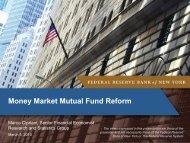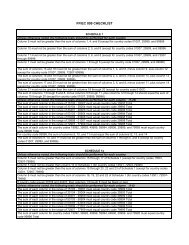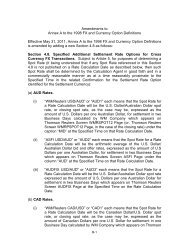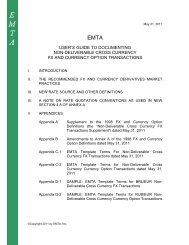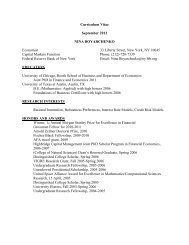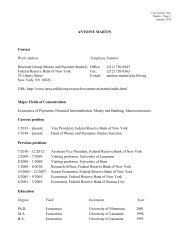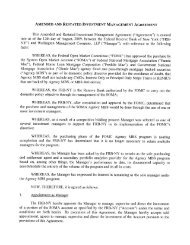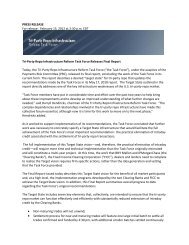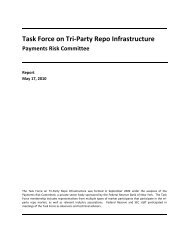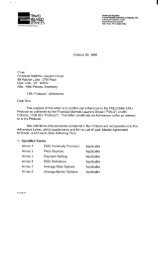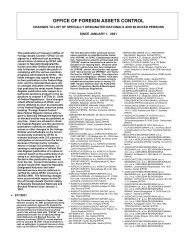Residential Foreclosures in the City of Buffalo, 1990-2000 - Federal ...
Residential Foreclosures in the City of Buffalo, 1990-2000 - Federal ...
Residential Foreclosures in the City of Buffalo, 1990-2000 - Federal ...
You also want an ePaper? Increase the reach of your titles
YUMPU automatically turns print PDFs into web optimized ePapers that Google loves.
By separat<strong>in</strong>g out transition<strong>in</strong>g census tracts, we can compare foreclosure rates<br />
between stable m<strong>in</strong>ority and stable white tracts. Stable m<strong>in</strong>ority tracts demonstrate a<br />
somewhat higher rate <strong>of</strong> foreclosure than <strong>the</strong>ir white counterparts, 0.54 percent as<br />
opposed to 0.38 percent. However, <strong>the</strong> rate <strong>of</strong> stable m<strong>in</strong>ority tracts is only about half <strong>the</strong><br />
rate <strong>of</strong> tracts that changed from white to m<strong>in</strong>ority. Clearly, it is <strong>the</strong> census tracts that are<br />
transition<strong>in</strong>g from white to m<strong>in</strong>ority that are experienc<strong>in</strong>g <strong>the</strong> greatest <strong>in</strong>cidence and rate<br />
<strong>of</strong> foreclosure.<br />
We <strong>the</strong>n test how <strong>the</strong> rate <strong>of</strong> transition correlates with foreclosure. In Table 5, we<br />
calculate foreclosure rates based on <strong>the</strong> rate <strong>of</strong> m<strong>in</strong>ority population <strong>in</strong>crease from <strong>1990</strong> to<br />
<strong>2000</strong>. As might be expected, <strong>the</strong> foreclosure rate is clearly <strong>the</strong> highest <strong>in</strong> tracts that<br />
experienced more than a 20 percent rise <strong>in</strong> m<strong>in</strong>ority population. However, it is worth<br />
not<strong>in</strong>g that <strong>the</strong>re is little difference <strong>in</strong> <strong>the</strong> rates between tracts that had a small <strong>in</strong>crease <strong>in</strong><br />
m<strong>in</strong>ority population and those that had no significant change. This f<strong>in</strong>d<strong>in</strong>g suggests that,<br />
as <strong>in</strong> <strong>the</strong> case <strong>of</strong> <strong>in</strong>come, <strong>the</strong>re may be a tipp<strong>in</strong>g po<strong>in</strong>t beyond which <strong>the</strong> correlation<br />
between m<strong>in</strong>ority change and foreclosure becomes significant. It appears that rapid<br />
m<strong>in</strong>ority change is <strong>the</strong> important factor <strong>in</strong> <strong>the</strong> association with foreclosure.<br />
Income and M<strong>in</strong>ority Status Comb<strong>in</strong>ed<br />
Chart 5 depicts <strong>the</strong> association between foreclosure and comb<strong>in</strong>ed <strong>in</strong>come and m<strong>in</strong>ority<br />
status. Us<strong>in</strong>g <strong>the</strong> same def<strong>in</strong>itions as we did earlier, we divide <strong>Buffalo</strong>’s census tracts <strong>in</strong>to<br />
four socioeconomic categories based on <strong>the</strong>ir m<strong>in</strong>ority population and median household<br />
<strong>in</strong>come <strong>in</strong> <strong>2000</strong> and calculate foreclosure rates for <strong>the</strong>se group<strong>in</strong>gs. <strong>Foreclosures</strong> are<br />
clearly most likely to occur <strong>in</strong> higher <strong>in</strong>come m<strong>in</strong>ority census tracts. These<br />
neighborhoods are likely to provide some <strong>of</strong> <strong>the</strong> region’s better homeownership<br />
opportunities for low- and moderate-<strong>in</strong>come m<strong>in</strong>orities.<br />
25



